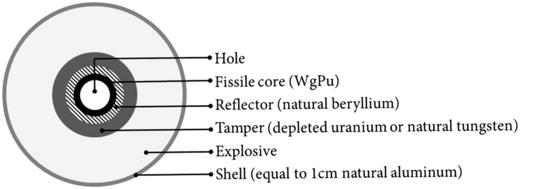 It is common scientific practice to focus attention on one major variable at a time, to the exclusion of everything else, to gain greater insight into how something works. The three articles in this issue of the journal draw attention to the important knowledge that can be gained by looking at what seem to be minor effects or traces--an art of investigation made famous in detective fiction by Sherlock Holmes.
It is common scientific practice to focus attention on one major variable at a time, to the exclusion of everything else, to gain greater insight into how something works. The three articles in this issue of the journal draw attention to the important knowledge that can be gained by looking at what seem to be minor effects or traces--an art of investigation made famous in detective fiction by Sherlock Holmes.
The first article in the issue is "A Passive Method for the Detection of Explosives and Weapons Grade Plutonium in Nuclear Warheads" (Free PDF) by Huang Meng, Zhu Jianyu, Wu Jun, and Li Rui. The article takes up the fundamental and long-standing question of verifying that a declared object is a nuclear weapon for arms control purposes, which was addressed in this journal in 1989 in its very first issue; see Theodore B. Taylor, "Verified Elimination of Nuclear Warheads" (Science & Global Security 1 (1989): 1-26).
The new article uses computer modeling of simple nuclear weapons to suggest a passive authentication method that relies on the presence of the conventional explosive used to implode the plutonium core in the warhead. The underlying claim is that the presence of plutonium and conventional explosive together in an object is sufficient to identify it as a possible nuclear weapon. The article simulates the spontaneous and fission neutron flux from the plutonium core and its effects on the chemical explosive through (n, γ) reactions with hydrogen, carbon, and nitrogen and the resulting flux of γ-rays. This method also makes it possible to distinguish the type of chemical explosive used in the warhead.
The second article in this issue is "Nuclear Archaeology to Distinguish Plutonium and Tritium Production Modes in Heavy Water Reactors" by Julien de Troullioud de Lanversin, Malte Göttsche, and Alexander Glaser. This picks up a problem highlighted by Steve Fetter in this journal in 1993 of the need for nuclear archeology tools to distinguish between the production of plutonium and tritium in dedicated reactors for verification purposes; see Steve Fetter, "Nuclear Archeology: Verifying Declarations of Fissile-Material Production," (Science & Global Security 3 (1993): 237-259). Tritium gas is used to boost the yield of the fission stage of modern nuclear weapons and must be regularly refreshed in operational weapons since it decays with a half-life of 12.3 years.
This article explores how the neutron flux spectrum of a heavy-water reactor core may differ depending on whether the reactor is producing only plutonium or producing tritium, and how this shifts the reaction rates of certain isotopes and leads to a difference in the expected ratios of these isotopes, which could be part of the physical structure of the reactor. Hafnium and tungsten are identified as candidate isotopes that could serve as archeological tracers to signal whether the reactor was operated in a plutonium mode or a tritium mode. The results are relevant both to confirming a state's declared production of plutonium (or tritium) as part of an arms control measure and also for verification of a possible fissile material cutoff treaty that ended plutonium production for nuclear weapon purposes but permitted tritium production to sustain existing arsenals.
The final article in this issue is "Proliferation Relevance and Safeguards Implications of Partitioning and Transmutation Nuclear Fuel Cycles" by Erik Buhmann and Gerald Kirchner. It assesses the significance of neptunium, americium, and curium, usually taken as minor actinide elements in the proliferation analysis of nuclear fuel cycles compared to plutonium, for the safeguarding of proposed Generation IV nuclear power reactors. Some Generation IV designs seek to use plutonium and some of the other actinides as fuel elements after they are separated from the spent fuel of current light water reactors. The declared goal being to "burn" the actinide waste as fuel and so mitigate the nuclear spent fuel disposal problem.
The article shows that multiple cycles of separation and recycling of plutonium and the other actinides would be required, and that this would carry a considerable additional safeguards burden. Modeling suggests a full-scale industrial Generation IV fuel cycle with separation and recycling would circulate large quantities of plutonium, neptunium, and americium, measured in terms of the respective estimated bare critical masses for the expected isotopic mixtures. This would imply the need for safeguards at fuel cycle facilities and during storage and transport. The models also suggest that actinide separation and recycle would have to be repeated many times to significantly reduce their initial abundance and that may take over 100 years of reactor operation. The article observes that moving to a "full-scale industrial partitioning and transmutation fuel cycle" means "the existence of a globally accepted treaty including comprehensive safeguards agreements like the Non-Proliferation Treaty is required for at least 200 years, to limit the proliferation risks created by introducing this technology."
